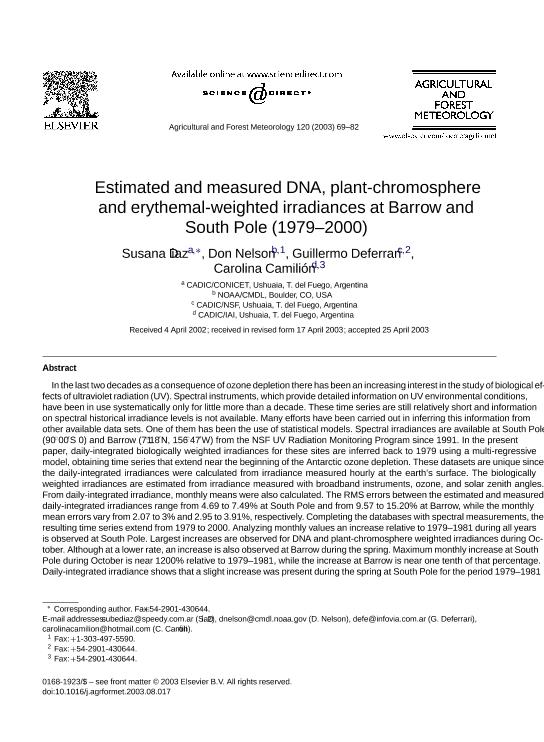Artículo
Estimated and measured DNA, plant-chromosphere and erythemal-weighted irradiances at Barrow and South Pole (1979-2000)
Fecha de publicación:
12/2003
Editorial:
Elsevier Science
Revista:
Agricultural And Forest Meteorology
ISSN:
0168-1923
Idioma:
Inglés
Tipo de recurso:
Artículo publicado
Clasificación temática:
Resumen
In the last two decades as a consequence of ozone depletion there has been an increasing interest in the study of biological effects of ultraviolet radiation (UV). Spectral instruments, which provide detailed information on UV environmental conditions, have been in use systematically only for little more than a decade. These time series are still relatively short and information on spectral historical irradiance levels is not available. Many efforts have been carried out in inferring this information from other available data sets. One of them has been the use of statistical models. Spectral irradiances are available at South Pole (90.00S 0) and Barrow (71.18N, 156.47W) from the NSF UV Radiation Monitoring Program since 1991. In the present paper, daily-integrated biologically weighted irradiances for these sites are inferred back to 1979 using a multi-regressive model, obtaining time series that extend near the beginning of the Antarctic ozone depletion. These datasets are unique since the daily-integrated irradiances were calculated from irradiance measured hourly at the earth’s surface. The biologically weighted irradiances are estimated from irradiance measured with broadband instruments, ozone, and solar zenith angles. From daily-integrated irradiance, monthly means were also calculated. The RMS errors between the estimated and measured daily-integrated irradiances range from 4.69 to 7.49% at South Pole and from 9.57 to 15.20% at Barrow, while the monthly mean errors vary from 2.07 to 3% and 2.95 to 3.91%, respectively. Completing the databases with spectral measurements, the resulting time series extend from 1979 to 2000. Analyzing monthly values an increase relative to 1979–1981 during all years is observed at South Pole. Largest increases are observed for DNA and plant-chromosphere weighted irradiances during October. Although at a lower rate, an increase is also observed at Barrow during the spring. Maximum monthly increase at South Pole during October is near 1200% relative to 1979–1981, while the increase at Barrow is near one tenth of that percentage. Daily-integrated irradiance shows that a slight increase was present during the spring at South Pole for the period 1979–1981 paper, daily-integrated biologically weighted irradiances for these sites are inferred back to 1979 using a multi-regressive model, obtaining time series that extend near the beginning of the Antarctic ozone depletion. These datasets are unique since the daily-integrated irradiances were calculated from irradiance measured hourly at the earth’s surface. The biologically weighted irradiances are estimated from irradiance measured with broadband instruments, ozone, and solar zenith angles. From daily-integrated irradiance, monthly means were also calculated. The RMS errors between the estimated and measured daily-integrated irradiances range from 4.69 to 7.49% at South Pole and from 9.57 to 15.20% at Barrow, while the monthly mean errors vary from 2.07 to 3% and 2.95 to 3.91%, respectively. Completing the databases with spectral measurements, the resulting time series extend from 1979 to 2000. Analyzing monthly values an increase relative to 1979–1981 during all years is observed at South Pole. Largest increases are observed for DNA and plant-chromosphere weighted irradiances during October. Although at a lower rate, an increase is also observed at Barrow during the spring. Maximum monthly increase at South Pole during October is near 1200% relative to 1979–1981, while the increase at Barrow is near one tenth of that percentage. Daily-integrated irradiance shows that a slight increase was present during the spring at South Pole for the period 1979–1981 .00S 0) and Barrow (71.18N, 156.47W) from the NSF UV Radiation Monitoring Program since 1991. In the present paper, daily-integrated biologically weighted irradiances for these sites are inferred back to 1979 using a multi-regressive model, obtaining time series that extend near the beginning of the Antarctic ozone depletion. These datasets are unique since the daily-integrated irradiances were calculated from irradiance measured hourly at the earth’s surface. The biologically weighted irradiances are estimated from irradiance measured with broadband instruments, ozone, and solar zenith angles. From daily-integrated irradiance, monthly means were also calculated. The RMS errors between the estimated and measured daily-integrated irradiances range from 4.69 to 7.49% at South Pole and from 9.57 to 15.20% at Barrow, while the monthly mean errors vary from 2.07 to 3% and 2.95 to 3.91%, respectively. Completing the databases with spectral measurements, the resulting time series extend from 1979 to 2000. Analyzing monthly values an increase relative to 1979–1981 during all years is observed at South Pole. Largest increases are observed for DNA and plant-chromosphere weighted irradiances during October. Although at a lower rate, an increase is also observed at Barrow during the spring. Maximum monthly increase at South Pole during October is near 1200% relative to 1979–1981, while the increase at Barrow is near one tenth of that percentage. Daily-integrated irradiance shows that a slight increase was present during the spring at South Pole for the period 1979–1981.
Palabras clave:
Climate impacts,O3,UV, Solar, radiation ,Irradiance
Archivos asociados
Licencia
Identificadores
Colecciones
Articulos(CADIC)
Articulos de CENTRO AUSTRAL DE INVESTIGACIONES CIENTIFICAS
Articulos de CENTRO AUSTRAL DE INVESTIGACIONES CIENTIFICAS
Citación
Diaz, Susana; Nelson, Don; Deferrari, Guillermo Alejandro; Camilión, María Carolina; Estimated and measured DNA, plant-chromosphere and erythemal-weighted irradiances at Barrow and South Pole (1979-2000); Elsevier Science; Agricultural And Forest Meteorology; 120; 1-4; 12-2003; 69-82
Compartir
Altmétricas




